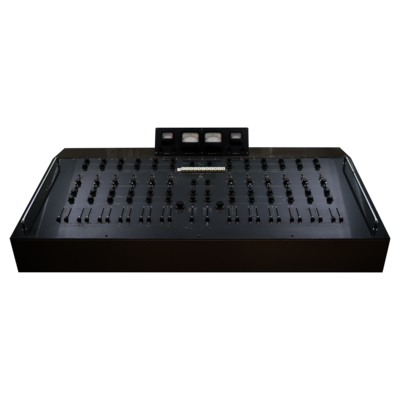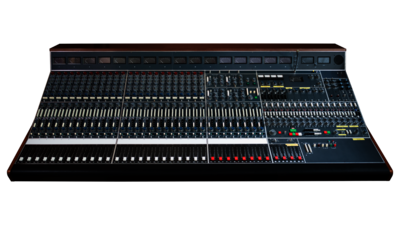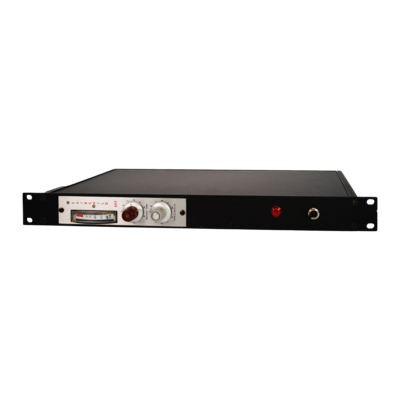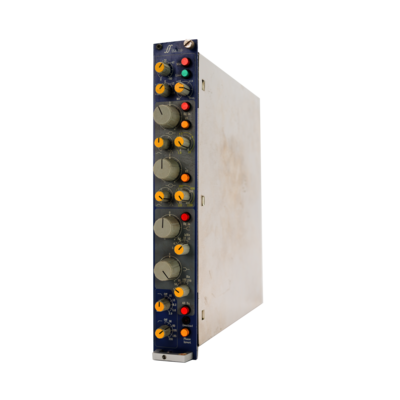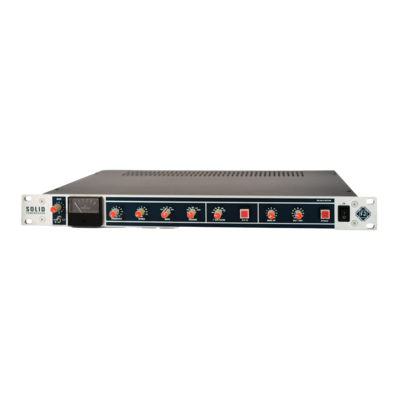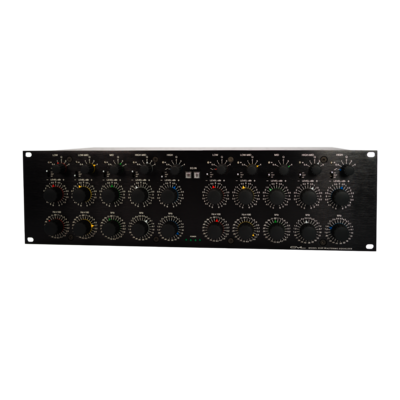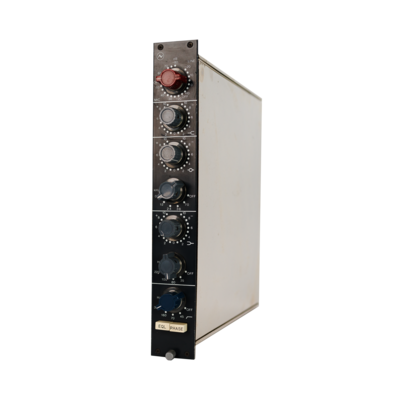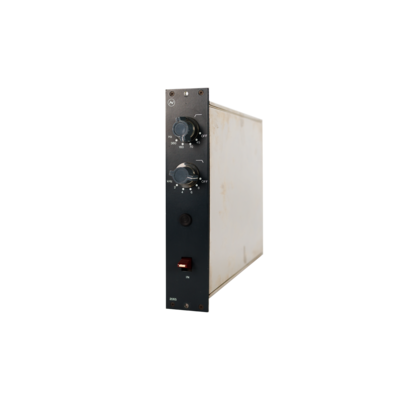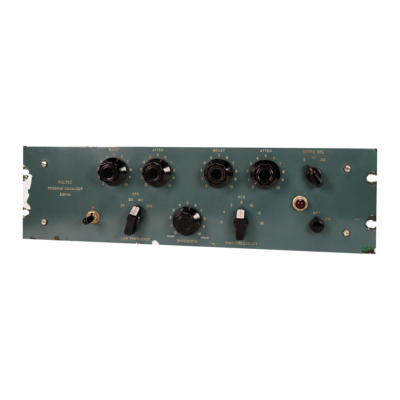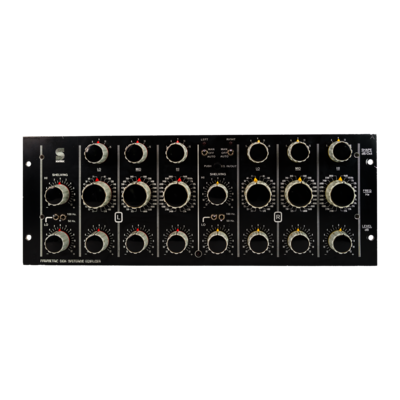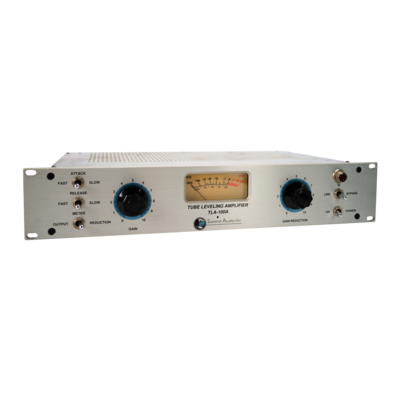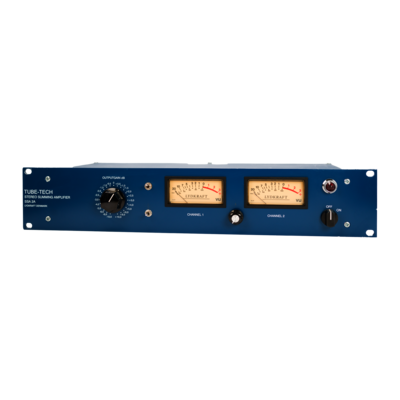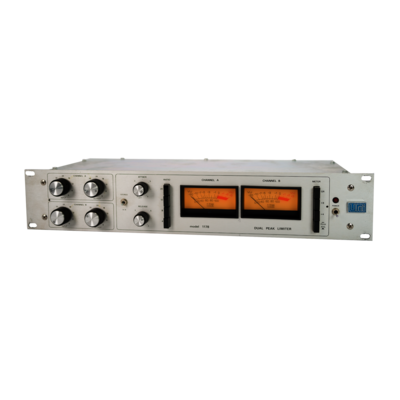EMI Pathé Marconi
EMI TG12345 MKQ
NEVE 5300 SIDECAR
NEVE 8016 Custom
NEVE 8068 MK II CUSTOM
TAB Telefunken Console
UNIVERSAL AUDIO CUSTOM
EMI Pathé Marconi
This is the historic 24 channel "large format console" from EMI / Pathe Marconi, designed & built for the studio of the same name.Unique in its kind - unique in the world.
This more than special console comes out of the late 60´s.
Pathe Marconi is the name of the studio and Boulogne Billancourt the place, south west of Paris, after the Porte d'Auteuil near Parc des Princes and the Roland Garros tennis stadium.
Also the Beatles dropped in to Pathe Marconi Studios in January 1964…
EMI's West German imprint, Electrola Gesellschaft, had been attempting to convince Brian Epstein and George Martin that they could only sell Beatles records if they were in German.
The session had originally been scheduled to take place on 27 January 1964, but The Beatles had proved reluctant to attend. George Martin eventually persuaded them to fulfil the obligation, and so they entered the Pathé Marconi Studios in Paris to record new versions of their two biggest hits. They recorded new vocals for “She Loves You”,”’I Want to Hold Your Hand” and “Can’t Buy Me Love”
The Rolling Stones show up in the studio in 1982. At this time it was their second home. A kind of new Olympic studios for them.
EMI TG12345 MKQ
One of only two EMI winged TG12345 Mk.IV consoles ever built.
This beauty found it’s new home as main console at Prime Studios control room C, next to a EMI TG12410 transfer desk.
The iconic Abbey Road Studio’s EMI TG12345 Mk.IV recording consoles used between 1971 – 1983.
During the '70s and up until 1983, the TG12345 consoles (Marks I–IV) were the main desks used at Abbey Road Studios, contributing to the sound of timeless albums such as Pink Floyd’s The Dark Side of the Moon and Wish You Were Here, John Lennon’s Plastic Ono Band, George Harrison’s All Things Must Pass, and many more.
Only two of the Mk.IV series were ever build - custom-made by EMI engineers specifically for the Abbey Road Studio.
The two TG12345 Mk.IV recording consoles were located in Studio 2 and Studio 3.
The TG was EMI’s first solid-state mixing desk. Its modular design was an innovative approach that enabled the quick replacement of faulty channel strips (or ‘Cassettes’ as EMI called them). Each Microphone Cassette contains two input channels that could be used independently or as a stereo pair.
One of the main features of the TG was the inclusion of a compressor/limiter in each channel, unique in console design at the time. The compressor/limiter was based on the valve Fairchild and Altec units that EMI used in the 1960s, but being a solid-state device, their sound was not the same.
Most engineers found the sound to be more aggressive than the old valve units and although popular, the trusty Fairchild 660s and Altec RS124s were still preferred for processing vocals and drums. Compression or limiting was selectable via a toggle switch, with COMP offering a 2:1 ratio similar to the Altec, and LIMIT giving a 8:1 ratio mimicking the Fairchild. Another of the TG’s features was its expanded EQ, which offered wider scope for shaping sounds than the old EMI REDD desks that had gone before.
The solid-state TG12345 had a much smoother and brighter sound than the valve REDD.51 it replaced. Some engineers complained that they were unable to get the gritty, edgy sounds they had achieved by overloading the valves in the older desks. The only Beatles album recorded with the TG was Abbey Road, and comparing the sound of that album with previous ones clearly shows off the TG12345’s inherently clean nature.
NEVE 5300 SIDECAR
Neve Melbourn – Classic Neve 12 channel sidecar. These beautiful small discrete 12 channel desks were designed to accept the 33114 and/or 33115 mic pre/eq modules, great, smooth & punchy sounding Neve modules.Class A/B rather than Class A (as in the legendary 80 series larger format desks), the 33114/5 have the same mic preamps as the 1081 and comprehensive three band eq, making them punchier than a 1073 and so ideal for drums, and more modern music with raunchier dynamics.
Although limited to two aux’s which doesn't much matter for recording, the Melbourn has inserts and direct outputs plus decent centre section facilities. All in all, an incredibly desirable, great-sounding little lady.
NEVE 8016 Custom
A really special Neve 8016 out of Caribou Ranch Studios / Colorado!Classic 80 series 24 channel console (40 channels in mixdown) completely fitted with 1064 Pre/EQ modules and 2254 compressor/limiters.
After a four- month refurbishment, the console was send to us & installed in our Studio B2. The console's installation at Prime Studio control room B2 marks its return to Europe after over three decades in the states, where she became part of music history.
This Neve 8016's began her existence in1972, in London, where she was built. Original owner Sir George Martin used the console to produce albums for America and others before selling it to Caribou Ranch founder, James Guercio. Legendary in both, setting and sound, Caribou was a destination for major artists like Chicago, who recorded five studio albums on the Neve 8016; Elton John, for his album Caribou (named after the studio); and Earth Wind & Fire, who recorded two albums at the ranch, including the Grammy-winning “That's the Way of the World”.
After an electrical fire in 1985, the studio's doors were closed and much of the salvaged equipment was put into storage. Guercio ultimately donated the Neve 8016 to the University of Colorado at Denver, its last stop before Vintage King acquired the console and began restoration for Prime Studio.
Prime Studio's first session on the Neve 8016 was with drummer Gregg Bissonette, who has toured with the likes of Ringo Starr, Brian Wilson, David Lee Roth, Steve Vai and Toto, and played on recordings with the Counting Crows, Duran Duran and on the Grammy winning album Supernatural with Carlos Santana.
Quote Gerhard Buchbauer:"I was completely convinced that we found what we'd been looking for--it's not “only” a Neve, it really is one of a kind with the 1064 pre/eq modules, not to mention the incredible energy associated with this desk that really is a part of classic rock history."
NEVE 8068 MK II CUSTOM
This is a pure beast! Two combined Neve 8068 32 channel consoles with additional added eight channels that are currently used as Reverb/FX returns with full eq section & Flying Faders for more precise control than regular FX return.Neve 8068 custom – Classic 80 series 72 channel inline console (144 channels in mixdown) completely fitted with 31102 Pre/EQ modules, 16 busses & Martin Sound Flying Faders II+ automation system.
Quote from Vintage King about one half of this huge desk: “This beautiful Neve 8068 was owned by Bruce Hornsby and was recently decommissioned from his home studio where it resided for over a decade. It was purchased by Gerhard Buchbauer, the owner of Prime Studios in Austria, who has bought several other consoles from us including an EMI Abbey Road console and a 32 channel vintage Neve console. As with many other vintage consoles, this one has seen some wear and features a few changes since it was born in the Neve factory. The desk was modified to have an extra eight inputs and features a number of other modifications that our team chose to leave in place.”
These desks are considered by many as the quintessential classic Neve 80 series - the holy grail for tracking. They were used in the 70s and 80s and are still in use in premier studios around the world.
Universally considered to be one of, if not the best vintage Neve console for tracking and mixing. The 8068 is renowned for its remarkable sound quality: rich and full-bodied thanks to the “big iron” transformers; clear and “airy” highs, courtesy of its discrete Class-A design and linear wide bandwidth, all while maintaining an audiophile quality throughout the spectrum. This unbeatable sonic combination made the 8068 capable of handling a wide spectrum of acoustic and electric musical genres, including rock, jazz, and classical.
In the early years, the company moved its operation to the Cambridge area to the Priesthaus facility in Little Shelford in 1964. From this iconic building, Neve® designed and built the world’s first commercial transistor-based mixing console for Philips Recording Studio in London. The now well established Neve company had produced several custom consoles for distinguished studio clients.
Building on the early success, Neve moved into a purpose-built factory in Melbourn, near Cambridge, entering the broadcast field in 1968 by producing the diode-bridge 2253 limiter for ABC Weekend Television in the UK – the famous 2254 compressor/limiter was an evolution of the 2253, designed for music consoles. This innovation was followed by the world’s first solid-state switching matrix the following year, with Neve making its products available in North America for the first time.
TAB Telefunken Console
This 12 channel desk has been build for the “Deutsche Grammophon” & used for classical music recordings.It includes V72, V76s, U70 tube preamp modules (even one V72 for the talkback microphone…), U71 level meters, Eckmiller W86 high/low pass filters & the Eckmiller PF 5/8h filters.
It was used as a mobile recording console by the “Deutsche Grammophon”.
This mixer consists of 5 individual pretty heavy boxes: the center section, two boxes with build in preamps & meters and two boxes for wiring & microphones.
Two of these boxes had to be placed one on top of the other and the resulting two “packages” then had to be connected with metal rods.
This created a mobile table, in the middle of which the central unit was placed. The individual “boxes” were then quickly connected to the main section using Tuchel cables and the mobile tube mixer was ready for use.
Direct siblings or at least blood relatives of this console are the well-known REDD consoles.
A slightly modified version of the V72 modules, the V72S, were found in the famous REDD.17 and REDD.37 consoles as standard channel amplifiers. The V72S isn't much different from the standard V72. It is modified for EMI's 200 Ω standard and provides 6 dB higher output gain. The original V72 wasn't supposed to be replaced because the quality wasn't good, EMI simply wanted a cheaper replacement because the original amplifiers were so expensive.
UNIVERSAL AUDIO CUSTOM
An unbelievable sounding custom console.10 channels, with historic Universal Audio 610 mic preamps, Universal Audio 508 (A & A.V.) inductor 3 band Eq’s, 3 aux/echos, 3 busses, direct out per channel and a left - center - right master section - everything fully tube driven.
This beauty is specially built for use at Prime Studio with originally parts out of the Bill Putnam era - late 1950´s-1960´s.
Unlike today, in 1960 there were very few recording studios and they were mostly owned by the major record companies. Almost all recording consoles of the day were custom built using lever key switches, transformers and vacuum tube amplifiers & thats exactly what was achieved and implemented for Prime Studio with this console.
Completely custom made with originally parts out of the Bill Putnam era.
While the 610 was never sold as a complete console, the 610 modules were used as a basis for many consoles used at Bill's studios.
The UA 508 Envelopmental Equalizer is another of UA's earlier commercially available EQs. It is a no-loss, high- and low-frequency passive EQ designed to be used with modular amps like the 1008 tube amplifier or the 1108 solid-state amplifier.
Altec 438 C
Avalon Design AD 2022
Avalon Design AD 2044
Avalon Design AD 2055
Avalon Design VT 747
EAR 825 Q
Fairchild 663
FAIRCHILD 670
Focusrite Forte ISA 110
Funky Junk Solid
George Massenburg Labs 2030
George Massenburg Labs 8200
George Massenburg Labs 8900
George Massenburg Labs 9500
Helios F700 LWT
Locomotive Audio Model 14B
Locomotive Audio Model 286A
Manley Labs Massive Passive
Mercury M 66
Mesa Boogie Recording Preamp
Neve 1064
Neve 1081
Neve 1093
Neve 2065
Neve 2254 A
Neve 2254 E
Neve 31102
Neve 3115
Neve 32264a
Neve 33114
Neve 33115
Neve 83065
Prime Studio® MP 7077 - LPO 7073
Pulse Techniques EQH-2
Pulse Techniques EQP-I
Pulse Techniques EQP-IA
Pulse Techniques MEQ-5
PYE 4060
PYE 4060
Shadow Hills Mastering Compressor
Shep Neve Compressor Limiter
Sontec Parametric Disk Mastering Equalizer
Summit Audio Dual Programm Equalizer
Summit Audio EQP-200 B
Summit Audio TLA-100 A
TAB / Siemens U 73
TAB / Siemens V72
Tube Tech SSA 2A
Urei 1176 LN
Urei 1176 LN Blue Stripe
Urei 1178
Urei LA-3A
Urei LA-4
Ursa Major Space Station
WSW Dynamikbegrenzer
Avalon Design AD 2022
The AD2022 is Avalon's fourth generation of fully discrete, symmetrical Pure Class A microphone preamplifiers.The dual mono AD2022 includes the original sonic capabilities and transparency of the M2, M22 and M5 preamplifiers plus several additional features, including selectable microphone source loading for optimized cable/mic matching, improved high-voltage Class A regulated power supplies, two high Z instrument inputs, variable-passive high pass filter, quality/silver wiring and doubled plated circuit boards for superior low level signal transfer.
Avalon Design AD 2044
The AD2044 features 100% discrete, pure class A signal amplifier configured with high speed current monitored optical control elements.These "invisible" opto elements enable the AD2044 to deliver totally transparent, low noise gain reduction within the minimalist signal path design. No VCAs are incorporated.
Variable attack and release controls plus side chain access, provide unlimited creative control from soft compression to hard limiting.
Avalon Design AD 2055
This is a truly gorgeous piece of equipment! What sets it apart from other EQ´s is the design of its circuitry, which delivers excellent transient response and incredibly low noise even with the gain up all the way.Balanced DC inputs and an incredible bandwidth from 1 Hz to 500 kHz (yes, that's correct-slightly out of our range of hearing) contribute to this unit's open, airy sound.
Avalon Design VT 747
The stereo EQ on this unit is stunning! The air band is especially sweet. What sets this unit apart is the ability to switch between solid state and a tube signal path. Endless colours for any mix.The Avalon VT-747SP combines a creative stereo tube-discrete Class A spectral-opto-compressor with a musical six band program equalizer.
Ideal for high performance DAW input signal conditioning, stereo buss compression-EQ, stereo keyboards and analog mastering applications.
EAR 825 Q
The EAR 825 is a stereo equalizer for studio use where sound quality is the top priority.
Enter the genius of Tim De Paravicini, who knows a thing or ninety-nine about recording studio gear and vacuum tuber electronics. His EAR 825 Q vacuum tube amp is a five band pure valve circuit equalizer.
There are adjustable attack points and it is fully balanced. Tube compliment is six 6DJ8 / ECC88. Esoteric Audio Research Ltd was established in England in 1976.
EAR products have a history of winning a long list of awards in a range of different product categories.
Fairchild 663
Not the 670, but a really nice sounding little helper.The text of an original Fairchild advertising placement out of the 60´s:
“COMPACT COMPRESSOR - Now you can have a compressor for every mike channel with this miniature low cost Fairchild Compact Compressor... no larger than a slide type attenuator (actual size 12x7×4½ inches).
This Fairchild Model 663 Compact Compressor will provide. up to 20 db of compression with no increase in distortion. And the attack time of 40 milli- seconds with a variable threshold and variable release time of .3 to 7 seconds offers complete compressor flexibility and performance.
The Fairchild 663 Compact Compressor can be easily integrated into your present console to provide the ultimate answer to all level control problems.”
FAIRCHILD 670
The FAIRCHILD MODEL 670 incorporates two independent limiters in one chassis, which can limit either two independent signals, such as the left and right channels of a stereo signal, or the vertical and lateral components of the same.The latter is accomplished by first bringing the two stereo channels through a matrixing network, dividing them into their vertical and lateral components, limiting them independently, and recombining them through a second matrixing network into left and right channels.
Each half of the MODEL 670 uses only a single push-pull stage of audio amplification and an extremely high control voltage, with the result that the Automatic Gain-Controlled Amplifier never produces any audible or observable thumps.
A respected design engineer, Narma had been hired by Les Paul to design and build Paul's first 8-channel mixing console. He developed several early limiter prototypes, eventually deciding on the design of what would eventually become the now-famous 670.
This design was then licensed by Sherman Fairchild, who up to that point, had a company who's primary industry was building aircraft.
Fairchild decided to create an audio equipment company, and he hired Narma as the company's first chief engineer.
Focusrite Forte ISA 110
The first commercial Focusrite product - a combined equaliser and mic preamp designed by Rupert Neve, who set up Focusrite back in 1985 after parting company with Neve Electronics. He called his creation the ISA 110, a comprehensive preamp built with a Lundahl transformer and a Neve EQ circuit.It became the keystone product for which Neve founded his newest business venture upon, a boutique audio processor company he called Focusrite.
The circuits within the preamp were meticulously designed, and each unit was sourced and outfitted with military-grade parts. It was built with the intention of it being the best preamp money could buy, and Martin loved the module so much that he had Neve outfit his entire mixing console, in AIR Studios London, exclusively with ISA 110s.
It should be noted that these original consoles were not cheap. If you were to buy a pair of ISA 110s in the late 1980s, along with the required power supply and mounting rack, they would run you upwards of $7,000 (around $22,000 today).
Funky Junk Solid
There’s probably no compressor more iconic than the Solid State Logic bus compressor that first appeared in the SL 4000 E-Series console. Its reputation as being the ‘magic glue’ that could pull together any bus mix made it extremely popular in professional circles.Funky Junk has successfully reproduced the wide-knee characteristic of the E-Series bus compressor’s response curve at low ratios, so that small amounts of low-ratio compression start to occur well below the set threshold.
This compression increases in level and ratio as the signal levels rise, and the full compression ratio is reached only when the threshold has been crossed.
Combining 2-3dB of compression with a low ratio, an automatic release time and an attack time that preserves the faster transients gives a result that pulls the bus together and that, with a bit of the dry signal mixed back in, can sound extremely natural whilst remaining well controlled.
This is where the real ‘magic’ lies.
George Massenburg Labs 2030
Our “go to” mastering compressor - quality & sound without any compromise.Twenty-two years of progressive research into loudness perception resulted in a limiter/compressor unlike any other. The 2030 Dynamic Range Controller was intrinsically developed to react to loudness (rather than volts) like our ears do.
The 2030 Mastering Dynamic Gain Control is the precision tool for mastering and other critical applications where the utmost in calibrated control, flexibility, and audio transparency is required.
Based on the proven GML 8900 Series III audio and control topologies, this no-compromise dynamic range controller continues the GML engineering tradition and expands the familiar capabilities of the Model 8900 to include flexible multi-channel, multi-controller deployment.
George Massenburg Labs 8200
The 8200 was the first fully parametric equalizer in history.At first glance, it seems to have been developed for pedantic control freaks. One might think you’d have to be real fun at parties to enjoy a device that allows you to boost 164 Hz by 0.3 dB with a filter Q setting of 0.8 and minimal coloration.
Gear-wise, the George Massenburg Labs 8200 is the pursuit of pure perfection.
When you turn on a GML, it’s not just about pure perfection because even the GML 8200 has its will. It’s something like the sophisticated gentleman of EQs. Mojo is also sometimes a question of dosage, and more isn’t always more.
George Massenburg Labs 8900
Twenty-two years of progressive research into loudness perception resulted in a limiter/compressor unlike any other.The 8900 Dynamic Range Controller was intrinsically developed to react to loudness (rather than voltage) like our ears do.
This compressor will do exactly what you want. You can compress "the shit" out of it and you won't hear it.
"The GML George Massenburg Labs compressor is simply the cleanest, most usable compressor that has ever been made" -Steven Miller
George Massenburg Labs 9500
Brought to you by George Massenburg, the man who invented, together with Burgess Macneal, the very concept of parametric equalization, the GML 9500 Mastering Equalizer is the mastering-grade version of the industry-standard 8200.For over twenty years engineers have relied on Massenburg equalization to create sonic perfection, and both the 8200 and the GML9500 can be found on virtually every major recording studio's racks.
It's that clear! George Massenburg created the GML9500 for no-compromise audio environments in which the wrong master EQ could mean the difference between a Grammy and an also-ran.
The 9500 is the Mastering Version of the 8200. The Gain, Frequency, and Q controls are fully-detented for absolute precision and repeatability.
With 1/2dB steps of Boost and Cut and 24 different frequency choices per band, the 9500 is a powerful and comprehensive workhorse for Mastering Engineers around the world.
Locomotive Audio Model 14B
Locomotive Audio's single channel 14B compressor and limiter is based on a very old, but still very exciting concept of rebiasing the input tube with a sidechain control voltage. After all, some of the most famous compressors in history, such as the Fairchild 670, Gates Sta-Level and Collins 26U, employed this very technique.The results are a sound that cannot be replicated with other ways of gain reduction. The Locomotive Audio 14B and its added modern features allow it to achieve a unique sound in its own right.
Authentic to the design aesthetic of classic vintage vari-mu and optical compressors of the 1940s − 1960s, the Locomotive Audio 14B-HW (handwired) is built with the same labor intensive care and attention to detail.
Every wire and component is selected and soldered by hand, ensuring each unit is special. Adding this artistic centerpiece to your rack is truly inspiring.
Locomotive Audio Model 286A
From beautiful glowing vocals, natural acoustics and punchy drums to overdriven and saturated classic tube warmth - Locomotive Audio Model 286A Dual Preamp offers a huge sonic palette for engineers and producers to explore.Its single-ended Class A tube signal path is what makes this preamplifier so special. Inspired by the great vintage Ampex 601 vacuum tube tape recorder, the 286A features two tubes per channel, one EF806 and one 12AY7.
The 286A can play nice by acting clean and natural with gentle even-order harmonics for a smooth, sweet touch. Get more aggressive with the "Gain" knob and drive the first 12AY7 stage for a warm and coloured thickening effect.
Go all-out and slam the final 12AY7 stage and output transformer through the "Level" knob for a fully-driven, saturated tube amp sound! Clean and natural to overdriven and fuzzy warm; your choice!
Mercury M 66
The Mercury 66 is an all tube and all transformer, fully-balanced variable-bias limiting amplifier. The most sought after product in this genre has been the legendary Fairchild 660.Which is recognized as an essential tool for making great recordings. Many manufacturers have tried to copy the Fairchild but have failed to capture the sonic essence. Until now.
This is the pen ultimate vari-mu Fairchild 660 'ish' compressor and the flagship of Mercury Recording line of vintage reproductions.
Just sending a signal through this box will make you smile. You want Ringo´s cymbal crunch - look no further. You gain that vintage warmth found only in tube gear and this guy has 8 tubes and weighs 38 pounds. Well... let's just say its a thing of beauty just looking at it.
Quote: “Some might ask, "Why recreate one of the most complicated pieces of recording equipment ever made?" The answer is: the Mercury 66 Studio Limiting Amplifier is based on the classic Fairchild 660 limiting amplifier because we were inspired by the unique sound that only this circuit can deliver to your audio signal path.”
There is truly nothing else like it. The Mercury 66 sounds like a Fairchild 660.
Mesa Boogie Recording Preamp
The Mesa Rectifier recording preamp is the first direct-recording preamp, that really deserves the name Mesa Rectifier.Several years of developmental work where necessary to create the realistic recto-sound without power tubes, speakers, air in motion and microphones in a typical direct-recording scenario. Built with 6x 12AX7A, the preamp features two independent channels with three sound-modes each - that has established the fame of the Dual Rectifier Solo Head.
With independent record- and live-outs, parallel FX-loop.
No digital modeling - the Real Thing!
Neve 1064
One of the most musical sounding preamps and EQs ever.The Neve 1064 is a Class A discrete Mic Pre/ 3-band EQ - originally designed for Neve 80 series consoles. The preamplifier and equalizer are the same as a 1066, but in a longer module to fit 1081-size slots.
Formed in 1961, Rupert Neve & Co. was focused from the beginning on designing and building the highest quality professional audio components. After establishing itself in the marketplace, and moving from Rupert's house to a newly built factory in Melbourn, England, Neve went on to create three of its most iconic products: the 2254 Compressor/Limiter in 1968, the 1073 Mic Pre/EQ in 1970, and the 1081 Mic Pre/EQ in 1973.
Aimed at the broadcast market, these units were found in numerous custom-built Neve consoles of the day. And because so much of their work was customized, there are many variants on the basic 2254 Compressor and 1073 Mic Preamp, including different form factors, cosmetics, components and features.
Neve 1081
The Neve 1081 Classic Microphone Preamp/EQ is one of the most desired pieces of gear in the entire world. The 1081 made its first appearance in 1973 for Decca Studios in Paris and later starred in the Neve 8038 and 8048 consoles and is still being used on today's platinum-selling albums.The 1081 has incredible sensitivity, fast and musical response to transients, as well as distinctive Neve equalization featuring effective high- and low-pass filters created to separate unwanted signal outside the passband. It uses the older grey, red and blue Marconi knobs on a faceplate of RAF (Royal Air Force) blue-grey paint.
Formed in 1961, Rupert Neve & Co. was focused from the beginning on designing and building the highest quality professional audio components. After establishing itself in the marketplace, and moving from Rupert's house to a newly built factory in Melbourn, England, Neve went on to create three of its most iconic products: the 2254 Compressor/Limiter in 1968, the 1073 Mic Pre/EQ in 1970, and the 1081 Mic Pre/EQ in 1973.
Aimed at the broadcast market, these units were found in numerous custom-built Neve consoles of the day. And because so much of their work was customized, there are many variants on the basic 2254 Compressor and 1073 Mic Preamp, including different form factors, cosmetics, components and features.
Neve 1093
Same preamp as 1081 but extra mid band on the EQ. The EQs have different frequencies and the output transformers are also different, with a faster transient response that makes drum recordings sound bigger.The most elaborate EQ of any original "vintage" Neve module, and specially built for the EMI NEVE recording consoles. Only seven of those consoles were built.
The EMI Neve series of audio consoles were designed and produced by Neve in the early 70’s to the exacting standards of EMI’s engineers, to be utilised worldwide in EMI studios.
They are considered by many, including then Head of the Electrical Design Drawing Office at Neve, Geoff Tanner [Aurora Audio] to represent the all-time pinnacle of audio console design, and have been described as an 8078 on steroids, amongst many other superlatives.
Neve 2254 A
One of the landmark innovations in audio gear. Since its first appearance in 1969, the Neve 2254 Mono Limiter/Compressor has become a legend.The “A” iteration of this highly sought-after Neve compressor, with variable threshold for the compressor and fixed limiter attack. A superb compressor, favoured for its warm and silky compression style. Beautiful on a wide range of sources from vocals and acoustic to strings, brass, ensembles and more.
With all-discrete Class A circuitry, transformer-coupled inputs, and many innovations - like its bridge-driver design - the 2254 created a totally unique sound that can only be described as 'Neve'.
The famous 2254 series of compressor limiters had its birth in the Neve 2253, which was a limiter designed for broadcast use in accordance with the Experimental and Development Department (EDD) of the Independent Broadcast Authority (IBA), a regulatory body set up in the UK in 1972.
By adding a compression side chain to the original design, the 2254 was born. In its original configuration, the 2254 was used in both broadcast and recording consoles as built-in units, usually as part of the meter bridge.
Neve 2254 E
The other Neve 2254 - the "E" version has a fast & slow limiter while the “A" version has only the slow limiter.One of the landmark innovations in audio gear. Since its first appearance in 1969, the Neve 2254 Mono Limiter/Compressor has become a legend.
A superb compressor, favoured for its warm and silky compression style. Beautiful on a wide range of sources from vocals and acoustic to strings, brass, ensembles and more.
With all-discrete Class A circuitry, transformer-coupled inputs, and many innovations - like its bridge-driver design - the 2254 created a totally unique sound that can only be described as 'Neve'.
The famous 2254 series of compressor limiters had its birth in the Neve 2253, which was a limiter designed for broadcast use in accordance with the Experimental and Development Department (EDD) of the Independent Broadcast Authority (IBA), a regulatory body set up in the UK in 1972.
By adding a compression side chain to the original design, the 2254 was born. In its original configuration, the 2254 was used in both broadcast and recording consoles as built-in units, usually as part of the meter bridge.
Neve 31102
As the saying goes....if you are here looking at this, then you know what they are and what they do! Truly some of the best and most used mic pre-amps ever made.The Neve 31102 Mic Pre/3 Band EQ module originally came standard in legendary Neve 8058/8068/8088 consoles. To many, this was the finest sounding Class A mic pre/EQ module Neve ever made, with lots of Neve mojo. This is the same EQ/pre as the 1084. Or you can look at it as a 1073 with switchable top end, (10/12/16 kHz), a hi-q switch on mid's and lo-hi pass filters.
Formed in 1961, Rupert Neve & Co. was focused from the beginning on designing and building the highest quality professional audio components. After establishing itself in the marketplace, and moving from Rupert's house to a newly built factory in Melbourn, England, Neve went on to create three of its most iconic products: the 2254 Compressor/Limiter in 1968, the 1073 Mic Pre/EQ in 1970, and the 1081 Mic Pre/EQ in 1973.
Aimed at the broadcast market, these units were found in numerous custom-built Neve consoles of the day. And because so much of their work was customized, there are many variants on the basic 2254 Compressor and 1073 Mic Preamp, including different form factors, cosmetics, components and features.
Neve 3115
This is a classic early 1970s Neve broadcast model. Basically identical to the highly sought after 1081 modules. The differences were the frequencies used on the Equalizer.They sound just fabulous.
These are not Class A. They are A/B. They actually have a more aggressive sound for rock 'n roll over the Class A Neve's. Everything that's “bad” about them back in the day is what's good about them, today.
What most folks don't know. This has a variable gain microphone preamp. As you change gain. It changes the negative feedback loop. This changes the character of the sound. When gain staged correctly, without overloading. They sound beautiful. However, when gain staged too high. The preamp starts to go a little nonlinear. It starts to saturate the output transformer. And then it makes magic!
Formed in 1961, Rupert Neve & Co. was focused from the beginning on designing and building the highest quality professional audio components.
After establishing itself in the marketplace, and moving from Rupert's house to a newly built factory in Melbourn, England, Neve went on to create three of its most iconic products: the 2254 Compressor/Limiter in 1968, the 1073 Mic Pre/EQ in 1970, and the 1081 Mic Pre/EQ in 1973.
Aimed at the broadcast market, these units were found in numerous custom-built Neve consoles of the day. And because so much of their work was customized, there are many variants on the basic 2254 Compressor and 1073 Mic Preamp, including different form factors, cosmetics, components and features.
Neve 32264a
The class A/B Neve 32264, and it's close cousin the 32264A, is possibly the best compressor/limiter ever made.Legendary. Fast, clear, and punchy.
Great for setting lead vocals in the perfect sweet spot in the mix, and on most instruments, and across the mix buss. Limit and compress at the same time!
Originally found in vintage Neve 80 series consoles. Comparable to metal knob 33609 and other classic Neve compressors of that era. These compressors sound absolutely incredible.
Neve 33114
The Neve 33114 is a Class A/B Mic Pre with 3 band EQ and hi pass filter. The 33114 is very similar to the 1081, with only minor component differences for broadcast that do not affect the sound. Tight and punchy!Formed in 1961, Rupert Neve & Co. was focused from the beginning on designing and building the highest quality professional audio components. After establishing itself in the marketplace, and moving from Rupert's house to a newly built factory in Melbourn, England, Neve went on to create three of its most iconic products: the 2254 Compressor/Limiter in 1968, the 1073 Mic Pre/EQ in 1970, and the 1081 Mic Pre/EQ in 1973.
Aimed at the broadcast market, these units were found in numerous custom-built Neve consoles of the day. And because so much of their work was customized, there are many variants on the basic 2254 Compressor and 1073 Mic Preamp, including different form factors, cosmetics, components and features.
Neve 33115
The Neve 33115 is a Class A/B Mic Pre with 3 band EQ and hi pass filter. The 33115 is essentially one half of the EQ points of the 33114. Tight and punchy!Designed to 1974-1975 by Mr. Rupert Neve and his associates in Cambridge.
This amp uses the same technology, the same topology and the same electronics as its illustrious big brother, the 1081. This model, and the accompanying series (3114, 3117, 33115, 33114 and 33117), is simplified and more compact than the infamous 1081.
He equipped the "small" Neve consoles of the time (Melbourn) or Broadcast consoles (5315, 5316), while the 1081 equipped the 80 Studio Series consoles (8048, 8058, 8068 ) from the same period.
With a 3 band semi-parametric equalizer (against 4 for the 1081), it also has a high pass filter, a phase reverse switch and an on / off section of its correction.
The various names for the same model, 33115 - 3115 for example, designate electronically identical preamps but with slightly different cosmetics: "3" designating a different paint color : grey in one case, RAF Blue in the other, RAF meaning... Royal Air Force(!).
Sound quality ... Is it really necessary to talk about? It seems that time and history have already said everything about it...
Neve 83065
Amazing sounding vintage Neve stereo compressor/limiter.
Extremely rare and coveted.
The Neve 83065 was released in 1985, making it a relatively "modern" compressor, and evolved from classics like the Neve 2254 compressor. The 83065 is divided into two sections, with all stepped controls for instant recall.
Prime Studio® MP 7077 - LPO 7073
LPO 7073CLASS A Line Preamplifier & DI Vacuum Tube Saturator
- Dual mono line / instrument preamplifier
- Fully discrete circuit design
- 500 series format
- 12AX7 vacuum tube
- Line preamp gain 45 dB
- Instrument preamp gain 50 dB
- Dual input architecture
- Flexible TT inputs and outputs
- Output level LED VU meter
- +48V switchable phantom power
- -20 dB switchable PAD
- Switchable distortion effect
- Switchable phase reverse
- Switchable simultaneous line and DI functionality
- Handcrafted with selected components
- Op-amp design by Charly Bohaimid
MP 7077
CLASS A Microphone Preamplifier & DI
- Mono microphone preamplifier / instrument / line preamplifier
- Fully discrete circuit design
- 500 series format
- Mic preamp gain 64 dB
- Instrument / line gain 50 dB
- Dual input architecture
- Flexible TT input and output
- Output level LED VU meter
- +48V switchable phantom power
- -20 dB switchable PAD
- Switchable Hi Z
- Switchable phase reverse
- Handcrafted with selected components
- Op-amp design by Charly Bohaimid
Pulse Techniques EQH-2
Vintage Pultec EQH-2 Program Equalizer dating back to the 1950s, offering an exceptional audio experience.This iconic piece is highly sought after by artists and engineers,. With its signature sound-shaping capabilities, the Pultec EQH-2 has been the secret weapon behind legendary recordings by artists such as The Rolling Stones, Pink Floyd, and Miles Davis. Renowned engineers like George Martin, Quincy Jones, and Bruce Swedien have relied on its unique tonal characteristics and musicality.
Crafted during the golden era of audio equipment, this vintage Pultec EQH-2 is a testament to the craftsmanship and innovation of its time. The EQH-2 offers a wide range of frequency manipulation options, allowing you to sculpt and enhance the sound in a way that is both musical and precise.
Pulse Techniques EQP-I
Pultec founders Gene Shenk and Ollie Summerland unveiled the first passive program EQ in 1951. This EQP-1 was based on filter circuits licensed from Western Electric and sounded great, but suffered the gain insertion losses typical of any passive filter, so the duo upgraded their original unit to the EQP-1A, which followed the EQ section with a gain makeup stage using a push-pull design with 12AU7, 12AX7 and 6X4 vacuum tubes.Designed for broad equalization of program material, the EQP-1A had four low boost/cut frequencies, three high-cut frequencies and a choice of seven HF boost points, along with a bandwidth control for shaping the high boost curve.
Like many boutique entrepreneurs, Shenk and Summerland built every unit to order by hand in their true two-man operation. Other Pultec units included the EQ-H2 high-frequency equalizer, the MEQ-5 mid-band EQ and the EQP-1A3 (an EQP-1A in a two-rackspace chassis), as well as solid-state versions, which had silver-face front panels. The original company folded decades ago.
Pulse Techniques EQP-IA
Originally introduced in 1951 as the EQP-1 by Pulse Technologies and designed by Ollie Summerland and Gene Shank in New Jersey, USA, this iconic equaliser became a staple of recording and broadcast studios throughout the world. After a modification to the design, it was remodelled as the EQP-1A and was in production for 30 years in that form.The sound achieved by the Pultec EQP1-A is very musical and is generally used as an additive effect to add depth and warmth in the low-end frequencies and sparkle and air to the high-end frequencies. The EQP1-A is a Passive Program Equaliser with shelf boost and attenuate equalisation options for a Low Frequency section and a High Frequency section. You can both boost and attenuate at the same time, allowing for a unique resulting sound, although the manual states that you should not do this on the low frequency controls. Professional engineers, however, discovered a technique, over the years, using a combination of boosting and attenuating low frequencies to create the “low-end trick”.
This was particularly useful for adding extra punch to kick drums, acoustic guitars, vocals and bass guitars or indeed across the whole mix. This worked because the boost and attenuate shelves affected different frequency ranges.
Pulse Techniques MEQ-5
Magical tools revered for their ability to improve the sound of audio simply by passing signal through them. Pultec equalisers like the MEQ-5 are that stuff of legend. You’ve heard them on countless hits.
Use the Pultec MEQ-5 midrange equaliser to fine-tune this crucial frequency range in your mixes, while adding undeniable Pultec vibe too. The MEQ-5 dedicates its existence to everything between 200Hz and 7kHz. Thats where your vocal tracks are most vibrant, where your guitars have girth and body, and generally where mixes either shine or fall flat.
In classic Pultec fashion you get two bands of midrange boost and one attenuation band, and that’s all you need to add amazing mojo to any track with the Pultec MEQ-5 midrange equaliser.
The name Pultec is an abbreviation of Pulse Techniques Inc., a company that consisted of two men: Gene Shenk and Ollie Summerland. These electronic wizards made every piece of their gear by hand at their factory in Teaneck, New Jersey, not far from Les Paul’s house. In fact they even collaborated with Les on some projects.
Their EQ's were based on a design created by Gene Shenk (contrary to popular belief, only the negative feedback circuitry of the amplifier was licensed from Western Electric).With top-notch, hand-made craftsmanship and a unique sound, Pultecs remain one of the most sought after of the vintage passive equalizers.
PYE 4060
Thick, rich & gluey. Outstanding on guitars, snares, bass, etc. A very desirable compressor with its own unique sound.PYE started out as a technical instruments manufacturer in Cambridge, England, and eventually got into making television receivers and cameras for broadcast. After developing the earliest British transistors in the 50s, they developed one of the first Class A solid-state compressor/limiters in the 1960s.
Their PYE Limiter was an essential part of the 'British sound' of the classic rock era.
The PYE compressor saw extensive use at London's famed Olympic Studios during the golden era of rock recording in the late 60s, when the Rolling Stones (Beggars Banquet, Let It Bleed) and Led Zeppelin (debut album) were among the many artists recording there. Eddie Kramer had a stint at Olympic, and made regular use of the PYE comp on the classic early recordings of Jimi Hendrix.
PYE 4060
Thick, rich & gluey. Outstanding on guitars, snares, bass, etc. A very desirable compressor with its own unique sound.PYE started out as a technical instruments manufacturer in Cambridge, England, and eventually got into making television receivers and cameras for broadcast. After developing the earliest British transistors in the 50s, they developed one of the first Class A solid-state compressor/limiters in the 1960s.
Their PYE Limiter was an essential part of the 'British sound' of the classic rock era.
The PYE compressor saw extensive use at London's famed Olympic Studios during the golden era of rock recording in the late 60s, when the Rolling Stones (Beggars Banquet, Let It Bleed) and Led Zeppelin (debut album) were among the many artists recording there. Eddie Kramer had a stint at Olympic, and made regular use of the PYE comp on the classic early recordings of Jimi Hendrix.
Shadow Hills Mastering Compressor
Shadow Hills Industries (to use their full name) is a company that produces and sells one of the most flexible compressors ever …The Shadow Hills Industries Mastering Compressor created by enigmatic mastermind, Peter Reardon.
It is a mastering-grade compressor/limiter with two compressors (stereo or dual mono) in series and three different output transformer selections (Nickel, Iron, and Steel) to choose between clean, coloured, and dirty textures.
Shadow Hills serves the professional recording industry by constructing discrete audio paths in rugged antique military enclosures with versatile controls that remain highly functional to keep up with the changing landscape of modern recording and production.
Shep Neve Compressor Limiter
The Shep Neve SND6 is a high-quality construction of the classic Neve compressor, using numerous Neve components.This one is called SND6, based on the 33609 or 32264.
Shep Associates was started by Derek Stoddart, one of the five original engineers who worked for Rupert Neve at his home-based factory in England.
Some years after resigning from Neve in 1976, Shep Associates was created, after Derek got numerous requests to modify Neve consoles.
ith many ex-Neve employees at Shep, there was plenty of experience with the Neve consoles and modules.
Shep and Neve worked out a licensing agreement which allowed Shep to build the classic Neve modules in order to do custom work on their vintage consoles.
This included doing a mod to convert 1073 modules to 4-band with the addition of a switched high frequency band as well as an overlapping presence band.
Hand-built to the highest standards, all Shep modules are fully discrete, and use original style components wherever possible.
Sontec Parametric Disk Mastering Equalizer
Sontec MES-432C/6 is considered by many top engineers as the BEST Parametric Mastering Equalizer. The absolute standard in mastering equalizers.Created by the co-inventor of the parametric EQ Burgess Macneal (the other one is George Massenburg). According to him, 430/432 units since being introduced in the late 60s early 70s, have been used on more hit records than any other outboard mastering EQ.
It was over 51 years ago (1972) when the first ITI MES-430 Parametric Disk Mastering Equalizer appeared on the scene. Manufactured as a tool to assist ‘cutting engineers’ - you remember those guys, they cut the masters that were used to press weird-looking flat black round disks back in the day, called records.
Quote from Burger Macneal: “We could have written a book entitled; ‘Three hundred ways not to build an equaliser’...”
Summit Audio Dual Programm Equalizer
Summit EQP200 Dual Program Equalizer is essentially Summit's take on the Pultec EQ. Two channels of amazingly smooth and sweet EQ perfect for any signal.This passive tube EQ is an incredibly warm sounding and accurate equalizer, hand built in the USA to the most exacting standards.
Features: Two independent channels, Switch selectable frequencies ,Passive I/O circuits & hand crafted in the U.S.A.
This is the rare original version, not the "A" or "B" version, it is simply labeled Dual Program Equalizer.
For tech geeks... this one was designed and made while tech guru Dave Hill was still running Summit Audio.
Summit Audio EQP-200 B
The EQP-200B is the newer dual channel equalizer that replaces the venerable EQP-200(A) unit. The 200B offers a new low frequency six dB per octave shelving filter starting at 50Hz.Coveted by top professionals for decades, passive EQs have better phase coherence than active designs, and the inductors offer a rich, smooth harmonic quality.
The EQP-200B is an indispensable component to many key task's in the studio. From tracking to final touches to sparkle, the EQP-200B is the goto EQ!
In 1979, Michael Papp was running a record pressing plant and cassette duplication facility. He eventually moved into the business of buying and selling used audio gear from recording studios.
Seeing the great demand for old, used vacuum tube gear along with the high cost of upkeep and maintenance for these old products, Michael decided to try manufacturing new vacuum tube based products combining the sound and attention to detail of these old classics with the specifications and reliability of new, modern parts.
Summit Audio TLA-100 A
What a stunning compressor…Summit Audio’s first product was the TLA-100, created by Michael Papp and Crane Song founder Dave Hill. Though it shares some control characteristics with vintage equipment, it was designed with unique circuitry and methods of levelling /compression. This union between classic function and modern day methods and technology has been the cornerstone of all Summit Audio designs.
The TLA-100 is currently the longest standing continuously produced piece of outboard gear in our industry.
In 1979, Michael Papp was running a record pressing plant and cassette duplication facility. He eventually moved into the business of buying and selling used audio gear from recording studios.
Seeing the great demand for old, used vacuum tube gear along with the high cost of upkeep and maintenance for these old products, Michael decided to try manufacturing new vacuum tube based products combining the sound and attention to detail of these old classics with the specifications and reliability of new, modern parts.
TAB / Siemens U 73
Super rare and real legend! Best classic vintage German tube compressor - if you're reading this you must know what it is!The TAB U73 is the early model and the most difficult to find pieces of vintage gear. The U73 is one of the best sounding and fastest tube compressor / limiter ever built!
Nearly every record recorded and cut in Europe from 1959 to 1980 was mastered through U73. But the real fame of V72 and U73 was made thank to the great record by The Beatles at Abbey Road.
Although not as well-known as the classic Fairchild 660, the Telefunken U73 is in many ways its European counterpart. Like the Fairchild, it is a ‘variable-mu’ compressor/limiter which achieves gain reduction by varying the bias of a vacuum tube, and was originally intended for the same purpose: to control the dynamics of audio material being fed into a vinyl cutting lathe.
The U73 was developed in the late 50s by the IRT (Institut für Rundfunktechnik) and manufactured until 1980 by TAB Tonografie Apparatebau, makers of the legendary V76.
TAB / Siemens V72
Widely considered by some of the worlds handsomest audiophiles to be the greatest mic-pre of all time, and the crowning glory of the V series line.The old V72 preamps have become collectors items and one of THE Holy Grails for high-quality studio recordings. In other words: "The really hot shit!".
The V72 was a self contained amplifier with a fixed gain level of 34 dB. It was originally used as a microphone amplifier. By 1955 it was the standard pre-amplifier in German radio stations.
The North West German Radio (NWDR) working in cooperation with the Institute of Broadcast Technology (IRT) of Hamburg developed a complete new equipment standard for the German radio network. This led to the development of the historic V72 module.
The V72 was developed by the NWDR under the technical supervision of Professor Nestler between 1949 and 1952 as a microphone and main studio amplifier.
Tube Tech SSA 2A
The TUBE-TECH Stereo tube summing amplifier SSA 2A released in 2004.This is the discontinued SSA 2A model - when it comes to taking several high quality signals and summing them into the mother of all stereo channels, Tube Tech SSA 2A really takes the cake.
The Company behind the blue TUBE-TECH gear is Lydkraft.
Lydkraft was founded in Denmark in1977 by John G.Petersen and two partners.
Urei 1176 LN
The 1176 Peak Limiter is a dynamic range compressor designed by the American engineer Bill Putnam and introduced by UREI in 1967.The 1176 LN (Revision C) added low-noise circuits on additional circuit boards and reduced distortion and changed the faceplate to black (1970). It was inducted into the TECnology Hall of Fame in 2008.
The 1176 derived from the 175 and 176 tube compressors marked the transition from vacuum tubes to solid-state technology. At the time of its introduction, it was the first true peak limiter with all solid-state circuitry.
With its distinctive tone and its wide range of sounds, deriving from the Class A amplifiers, its input and output transformers, the uncommonly fast attack and release times and their program dependence, and different compression ratios and modes, the 1176 was immediately appreciated by engineers and producers and established as a studio standard through the years.
Urei 1176 LN Blue Stripe
The 1176 Peak Limiter is a dynamic range compressor designed by the American engineer Bill Putnam and introduced by UREI in 1967.The initial units (A and AB revisions) were available in 1967 and were informally referred as "blue stripe" for their blue-coloured meter section.
The 1176 derived from the 175 and 176 tube compressors marked the transition from vacuum tubes to solid-state technology. At the time of its introduction, it was the first true peak limiter with all solid-state circuitry.
With its distinctive tone and its wide range of sounds, deriving from the Class A amplifiers, its input and output transformers, the uncommonly fast attack and release times and their program dependence, and different compression ratios and modes, the 1176 was immediately appreciated by engineers and producers and established as a studio standard through the years.
Urei 1178
The Model 1178, released in 1979, is a two channel version of the very successful 1176LN Peak Limiter used in many recording studios, broadcast stations, sound reinforcement installations, etc. around the world. Essential vintage compressor for tracking, mix bus or stem processing.The Dual Peak Limiter was designed for those applications where two channels of program material are processed, and the balance of these audio channels must be maintained. The two limiters inside the Model 1178 are matched to assure the high degree of tracking necessary for critical stereo applications.
Urei LA-3A
The UREI LA-3A was designed by Brad Plunkett in the late 1960s.The LA-3A leveling amplifier made its debut at the 1969 NY AES show and marked the departure from the tube design of the Teletronix LA-2A leveling amplifier.
The LA-3A - like its tube-based papa - derived its response characteristics from the legendary T4b opto-isolator, which consisted of an electro-luminescent panel paired with a photo-sensitive resistor. The louder the signal coming in, the brighter the electro-luminescent panel. The photo-resistor reacts to this light and the signal gain is reduced.
The LA-3A incorporated components and design concepts from the Putnam-designed 1176LN Limiting Amplifier. Immediately embraced as a studio workhorse and still widely used today, the LA-3A remains a favourite of engineers and producers worldwide for its unique compression characteristics and sonic signature.
Urei LA-4
The LA-4 is one of the UREI legends released in 1977.The Universal Audio / Urei LA-4 Compressor/Limiter was the successor to the popular LA-3.
The UREI LA-4 Compressor/Limiter is a single-channel unit, although two may be strapped for stereo operation. Making use of URI's patented Electro-Optical Attenuator technology, the LA-4 offers smooth, predictable performance coupled with ease of operation.
The gain reduction is accomplished with an RMS detector, which is the analog of human hearing, so gain reduction is smooth and natural sounding.
Ursa Major Space Station
The Space Station, or SST-282, was described as a “reverberation effect.” It could apparently get reverb times of up to 3.5 seconds.This may not seem like a particularly long time by modern standards, but it was a huge achievement given the architecture that was used. In the SST-282, the reverb effect was obtained by using a single delay line, with 15 output taps from the delay buffer summed and used for feedback, and an additional 8 taps used to monitor the delay line. Multitap delay lines such as this, where several taps are summed and used for feedback, can quickly reach a high reflection density.
In 1977, Chris Moore resigned from his role as Project Engineer at Lexicon, and formed his own company, Ursa Major. Working form his cellar, Chris set out to design an affordable digital reverb. After great effort, in 1978 he released the Ursa Major SST-282 Space Station — the same year as the Lexicon 224 Digital Reverb, but at about one quarter the cost. Ursa Major was bought by AKG in 1985.
WSW Dynamikbegrenzer
Brand: Wiener Schwachstrom Werke (WSW)WSW Siemens WSW 601431 A Compressor / Limiter.
One of the finest vintage compressor / limiters you can find.
The built quality is superb German engineering the highest level possible.
It sounds very musical, warm and unique. It is transistor based but can kill tube Fairchild.
WSW (Wiener Schwachstrom Werke-> Vienna Lowcurrent Plant) was the Austrian branch of Siemens audio division and made similar looking versions of the Siemens and Klangfilm gear that was mostly identical in electronic design and circuit.
There are some WSW version of the V72 as well as the Movie EQs. During the late 60 early 70s WSW build am entire line of audio equipment that was mostly for the Austrian broadcast market. So, WSW is even better version of Siemens!!
